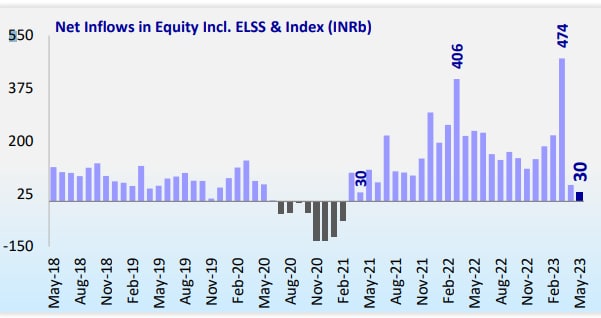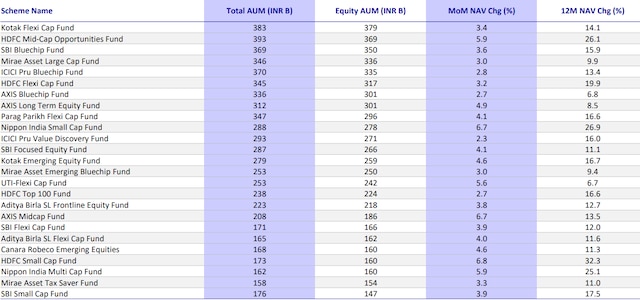Net inflows into equities decline to a 2-yr low: What should investors do?
Investors pulled out Rs 27,569 crore last month, the highest since September 2021, when equity MF units worth Rs 27,979 crore were redeemed. As a result, net inflows into equity schemes declined to Rs 3,240 crore in May. In April too, inflow in equity-oriented schemes dropped by nearly 3 times on a month-on-month basis to Rs 6,480.29 crore from Rs 20,534.21 crore in March 2023 despite indices like Sensex and Nifty 50 moving up. It appears investors may have chosen to be on the sidelines and are waiting for a correction to invest into equities.
“Inflows (ex-NFOs) into equity schemes have declined sharply in the last two months. Inflows in March 2023 were at Rs 16, 693 crore, which declined to Rs 4, 868 crore in April 2023 and further declined to Rs 3,066 crore in May 2023. As markets move higher, flows have reduced as investors turned cautious at higher market levels. Total inflow including NFOs in May was at Rs 3240 crore vs Rs 6480 crore in April,” said Sachin Jain, research analyst at ICICI Securities.
“While equity assets under management ( AUM) for domestic mutual funds (including ELSS and index funds) increased 4.3% month-on-month to Rs 18.4 trillion in May 2023,,fueled by a rise in market indices (Nifty up 2.6% MoM) and an increase in equity scheme sales (up 21% MoM to Rs 134 billion). At the same time, redemptions spiked 36.6% month-on month to Rs 311 billion Consequently, net inflows dipped to a two-year low of Rs 30 billion in May’23, noted brokerage Motilal Oswal in a note.

As seen above, redemptions in equities spiked in May’23 (up 36.6% MoM).
According to brokerage ICICI Securities, ETFs continue to see inflows while categories like balanced advantage funds have seen lower inflows/outflows in the last one year.
On a month-on month basis, the weights of NBFCs, Technology, Automobiles, Consumer, Retail, and Insurance increased, while the weights of Private Banks, PSU Banks, Utilities, Oil & Gas, Metals, and Media moderated.
Data analysed by Motilal Oswal shows that HDFC Small Cap Fund (+6.8% MoM change in NAV), Axis Midcap Fund (+6.7% MoM), Nippon India Small Cap Fund (+6.7% MoM), HDFC Mid-Cap Opportunities Fund (+5.9% MoM), and Nippon India Multi Cap Fund (+5.9% MoM) reported the highest month-on-month increase.

Equity funds: IT funds recover, small cap funds continue to outperform
Consumption funds have also outperformed in the last two months as sector rotation was witnessed with interest coming in segments like FMCG, auto, retail, which are a part of the larger consumption theme. Banking funds continued to perform well while pharma funds after short outperformance have lagged in performance in the last one month, he added.
In the last two to three months, from the lows in March 2023, BSE Small cap index was up 18% while the S&P BSE Sensex was up less than 10%.
Investors have now become more selective when it comes to equities
“For a number of months, all categories of equity funds saw net inflows. That has changed and investors have now become a lot more selective, which is not surprising considering the elevated levels of the market. Let us look at the equity fund categories that saw net inflows. Overall, equity fund saw net inflows of Rs3,240 crore in May 2023. In terms of key categories seeing inflows; Small Cap funds saw inflows of Rs3,283 crore, mid-cap funds Rs1,195 crore and large & mid cap funds Rs1,133 crore.
“With the equity market near an all-time high, investors are a little uncomfortable with respect to valuation. At the same time, money is getting parked in debt funds like liquid & ultra for an opportunistic time. The large cap has got small inflow this time although the mid and small cap segment has managed to get reasonable inflow as fund managers are looking for value buying within the space,” said Mukesh Kochar, National Head – Wealth at AUM Capital Market.
What should retail investors do?
What about your SIP investments?
“SIP investments in equity mutual funds build wealth over a long term, i.e. (5+ years). There is sufficient evidence that short-term volatilities do not have any meaningful impact on the portfolio returns over such long terms. Thus, SIP investors should ignore day-to-day market movements. Instead, they should adopt a goal-based investment strategy and stay disciplined with their SIPs,” said Ajinkya Kulkarni, Co-Founder and CEO, Wint Wealth.
“Investors should continue with the SIPs as the Indian economy continues to be resilient, FII flows in the Indian equity markets are strong and also IMF suggesting that India is the fasted growing economy. Therefore, one can take advantage of the correction in the Mutual funds’ NAVs. At this juncture, we believe that the peak of rate hikes in India and globally is coming to an end, which will lead to a reversal in the sectors which has being impacted by the rate hikes. The investors should continue investment, especially in the interest-sensitive sectors such as banking, infra and auto,” said Gurmeet Singh Chawla, Director, Mastertrust.
AUM Capital’s Kochar believes SIPs should not be stopped since the concept is based on discipline rather than timing. “Timing a market is very difficult and impossible. So the best thing is to continue with your SIP and keep on doing top-ups whenever the market falls substantially,” said Kochar.
“One of the primary objectives of the SIP mode of investment is to save investors from the hassle of market timing and thereby, ensure financial discipline and regular investing in them. Thus, SIP investors should base their redemption/pause decisions only on the basis of the maturity of their financial goals, changes in their risk appetite and/or continued under-performance of the funds they are already invested in. Only those nearing their financial goals can opt for redemption in a staggered manner,” advised Naveen Kukreja, Co – Founder & CEO, Paisabazaar.
 Loan, Personal Loan, Home Loan, Business Loan,Loans in India Loan in India, Personal Loan, Home Loan, Business Loan, Loans in India,Loan Finance,Loan in India, Get Instant Personal Loan,Home Loan, Business Loans in India
Loan, Personal Loan, Home Loan, Business Loan,Loans in India Loan in India, Personal Loan, Home Loan, Business Loan, Loans in India,Loan Finance,Loan in India, Get Instant Personal Loan,Home Loan, Business Loans in India